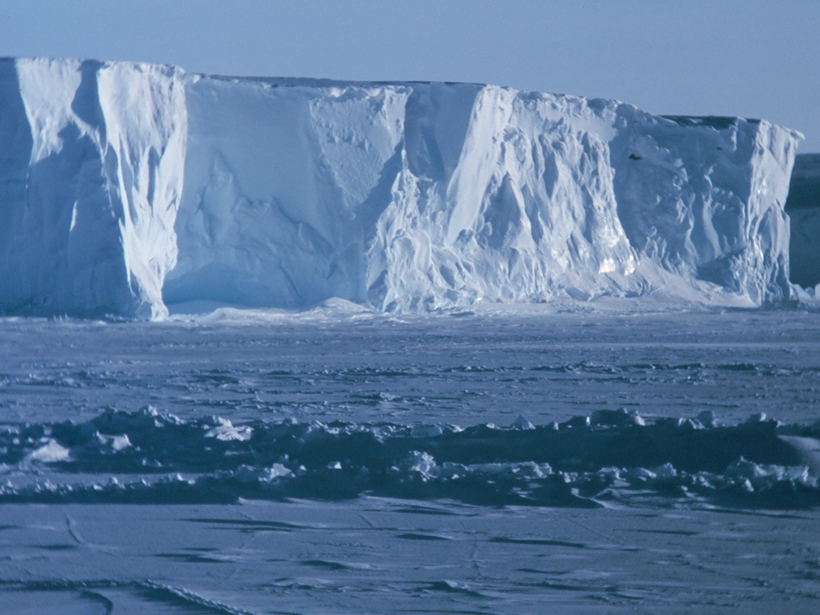Antarctica’s Ross Ice Shelf is a Spain-sized sheet of ice fed by the continent’s glaciers. But unlike other Antarctic ice shelves such as Larsen C, which recently calved a 1-trillion-metric-ton iceberg, the Ross Ice Shelf’s mass has remained roughly constant over the last several decades, even in the face of rising global temperatures. Now, researchers have dug into this mystery by drilling over 700 meters into the Ross Ice Shelf to sample the water beneath it. The team found that a layer of fresh, cold water that melts off the bottom of the ice shelf acts like insulation, protecting the underside of the shelf from melting further.
A Rare Peek Underneath
In 2015, members of the Whillans Ice Stream Subglacial Access Research Drilling (WISSARD) team used a heated drill to bore 755 meters through a very particular location along the Ross Ice Shelf: the so-called grounding zone. The grounding zone is a strip of the shelf located above the coast of the underlying Antarctic continent and under which the ice is transitioning from resting on the ground to floating. Although scientists have long regarded grounding zones as linchpins of ice sheet longevity, no one had previously drilled into this narrow portion of the Ross Ice Shelf, which extends about 10 kilometers from where the ice is securely frozen to the ground to where it’s all afloat. Melting in the grounding zone can affect ice loss across the entire shelf, which in turn is a major factor in sea level rise.
“It was expected that this [fresh] water would be sloshed around and mixed with the seawater.”
For roughly 2 weeks, WISSARD scientists lowered instruments through the meter-sized hole in the ice into dark, nearly freezing water to measure parameters like the water’s temperature, salinity, and flow rate. The researchers found that a roughly 1 meter thick layer of cold, fresh water blanketed the base of the ice shelf, said Carolyn Branecky Begeman, a glaciologist at the University of California, Santa Cruz. She is scheduled to report the finding this Thursday at the 2018 Ocean Sciences Meeting in Portland, Ore.
A Watery Surprise
This relatively placid freshwater layer, which floats on top of denser, saltier, warmer ocean water, acts like insulation, Begeman explained. And finding it in the grounding zone was a surprise, she added, because models suggest that tides ought to thoroughly mix Antarctic waters in the grounding zone. “It was expected that this [fresh] water would be sloshed around and mixed with the seawater as the tides go up and down,” she said.
The WISSARD team showed that melting was causing the underside of the Ross Ice Shelf near the grounding zone to annually lose a layer of ice less than 10 centimeters thick—a rate of loss lower than the average across the entire shelf. That’s good news, said Begeman. Higher melt rates cause the fresh water that’s released to move more quickly, which stirs up the surrounding water and drives further melting.
This data set gathered from beneath the grounding zone is extremely exciting and hard-won, said Paul Holland, an ocean scientist at the British Antarctic Survey in Cambridge, United Kingdom, who was not involved in the research. “For decades we have relied upon theoretical predictions of ocean behavior [near the grounding zone]…untested by observation,” he noted.
“It’s really hard to get measurements underneath the ice.”
Despite the new insight regarding the Ross Ice Shelf’s melt rate, scientists need to answer a crucial, broader question to project the rate of change ahead for the continent, said Begeman: How fast, in general, do ice shelves melt when they’re brought into contact with water with different temperatures and salinities flowing at various rates? New data are needed to answer that question, but we’re so “observation limited” that collecting them will be a challenge, Begeman said. “It’s really hard to get measurements underneath the ice.”
—Katherine Kornei (email: [email protected]; @katherinekornei), Freelance Science Journalist
Citation:
Kornei, K. (2018), Fresh insights into what protects Antarctica’s Ross Ice Shelf, Eos, 99, https://doi.org/10.1029/2018EO093057. Published on 13 February 2018.
Text © 2018. The authors. CC BY-NC-ND 3.0
Except where otherwise noted, images are subject to copyright. Any reuse without express permission from the copyright owner is prohibited.

